Smoking out the differences between 9 X 5 inch artworks, then and now
By Fiona Gruber
Greg Irvine’s 9 X 5 NOW work: Balcony in Havana 2017 [detail]. Oil, 9x5 inch.
From 16–25 June, 2017, the Victorian College of the Arts will stage 9 X 5 NOW, an exhibition featuring original artworks by more than 300 contemporary visual artists. The 9 X 5 title refers to the dimensions of the artworks, which are based on the size of cigar-box lids, as was the case in the original 9 by 5 Impression Exhibition in 1889. How have our artistic attitudes to smoking – and its accoutrements – changed since then?
Nothing reveals changing attitudes to smoking more than two works of art more than a century apart; Melbourne Impressionist painter Tom Roberts’ portrait of Dion Boucicault Junior was painted in 1895; it shows the dandified actor and theatre director leaning on a cane, cigar held nonchalantly in his right hand, a stream of smoke issuing from pouting lips. It’s relaxed, yet charged with sophistication, hinting at a night-time’s possibilities for a smartly-dressed young man about town.
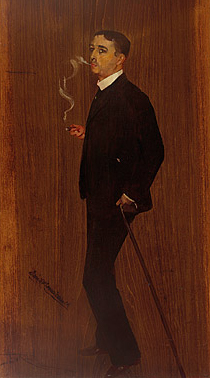
Courtesy the Collection of The Tallis Foundation, Beleura House and Garden, Mornington.
Melbourne painter Louise Hearman’s use of rotting teeth were in evidence at her recent survey show at Tarrawarra Museum of Art; the exhibition also featured a vitrine of cigarette packets with their graphic images of bodily disease and decay, including teeth, just to make the connection clear. In the canvasses on the walls, Hearman’s magic realist teeth appear in strange juxtapositions to nature, incongruous and repulsive.
Zoom back a century and a bit and the link between smoking and the bucolic were close and relatively benign. Tarrawarra’s sylvan setting in the Yarra Valley is the kind of location loved by Roberts and his fellow impressionist painters, Charles Conder, Fred McCubbin, Arthur Streeton and Jane Sutherland. Not that they roamed so far; the suburbs of Box Hill and Heidelberg were nearer and provided all the fresh air and bushy landscape they craved.
Back then, the world was a far smokier place; factories belched along the Yarra, furnaces melted and smelted, and home fires threw a dirty brown haze across the city. Although Melbourne was one of the first metropolises in the world to use electricity for public and domestic use, it was still a very sooty world.
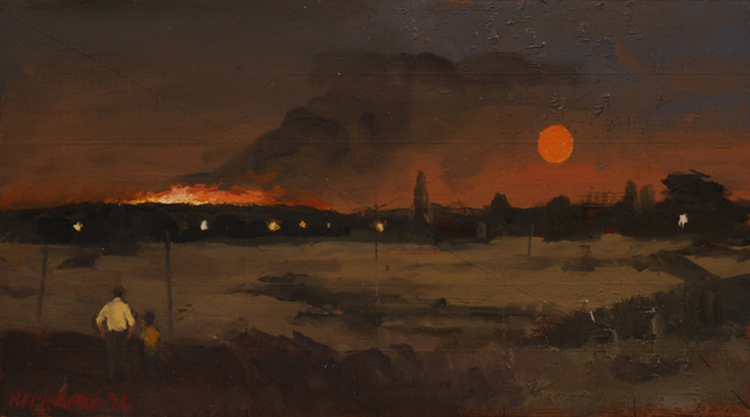
The artists would leave this dirty milieu behind at weekends, heading off to sketch and paint en plein air, catching the steam-belching, coal-fuelled trains that had transformed the city’s suburbs and hinterland. In their bags they carried a stash of boards, many of them discarded offcuts from the cigar and cigarette factory owned by the father of good friend and fellow artist, Louis Abrahams.
The factory of Snider and Abrahams was close by Buxton’s Rooms in Melbourne’s Swanston Street where the group were to hold their famed 9 by 5 Impression Exhibition in 1889; a warehouse built for the company that supplied the boards still stands, down Drewery Lane off nearby Lonsdale Street.
One of the sketches painted by Conder, Impressionists’ Camp, 1889, shows a couple of the artist’s companions in a cheaply-furnished room. Bottles stand on tables, a seated man reads a paper, another engages him in conversation, pipe in mouth.
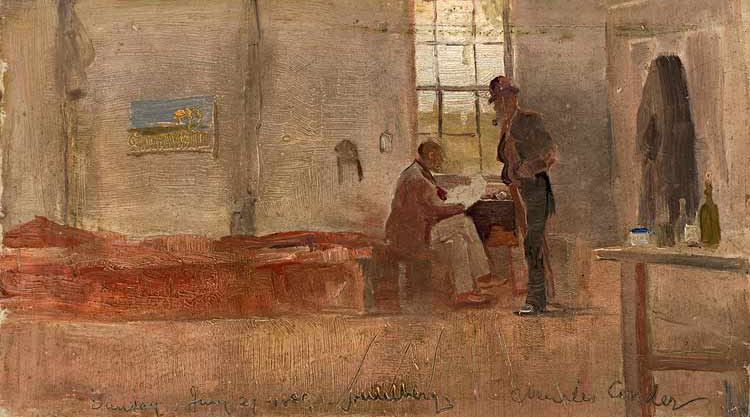
National Gallery of Australia, Canberra. Gift of Mr and Mrs Fred Williams and family.
It’s a casual scene of collegiality, relaxation and simple recreation.
The paintings on boards are impressions, intentionally sketchy, capturing a moment in time, the play of light, the cast of shadows, the way a landscape or street scene looked at a given moment. They are the antithesis of the carefully crafted and composed studio painting, a quick smoke break as opposed to the carefully prepared soirée.
Conder, aware of the stir such off-the-cuff work was about to provoke among the self-defined connoisseurs of Melbourne, jokingly added, in a handwritten invitation to his friend, the solicitor and arts patron Theodore Fink, that he should wear “smoked glasses to take of [sic] the glare of first impressions”.
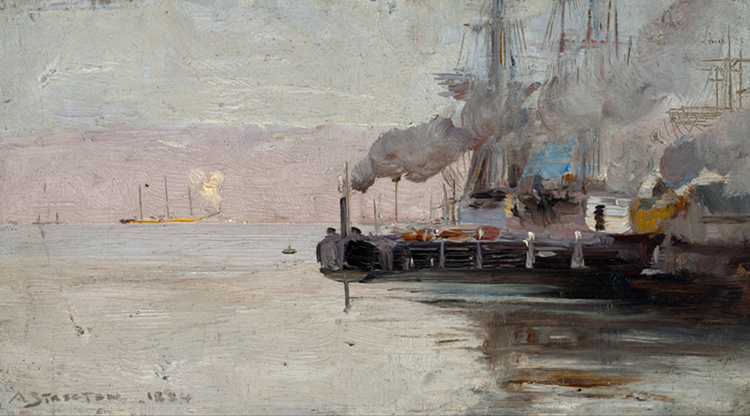
National Gallery of Australia, Canberra.
Fink mingled with the city’s jaunty and passionate young artists at smoke nights. These were hugely popular and very Australian, informally-formal gatherings where men hob-nobbed, smoked, ate dinner and often listened to music. They were regarded as smart and sophisticated salons were business and pleasure combined.
“Respectable” women didn’t take part and didn’t smoke, at least in public; in 19th-century art it was the vice of the good-time girl – a few decades later that changed when tobacco advertisers latched on to the suffrage movement and portrayed smoking as the rebellious habit of choice for every forward-looking modern female.
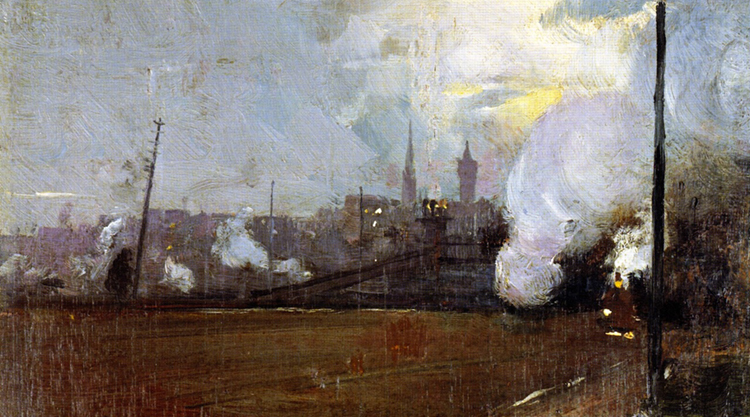
Art Gallery of NSW.
Nevertheless, smoking, a shortcut to lung disease, had come a long way since the 16th century when New-World merchants had started importing the withered leaves and paraphernalia of the indigenous Americans.
The Dutch Golden-Age paintings of the 17th century, with their red-faced tavern customers, flagons in one hand, clay pipe in the other, were just the start of a habit initially embraced by sailors, soldiers and the poor but which, by the turn of the 20th century, had become a vice subscribed to across the classes and especially among the convivial.
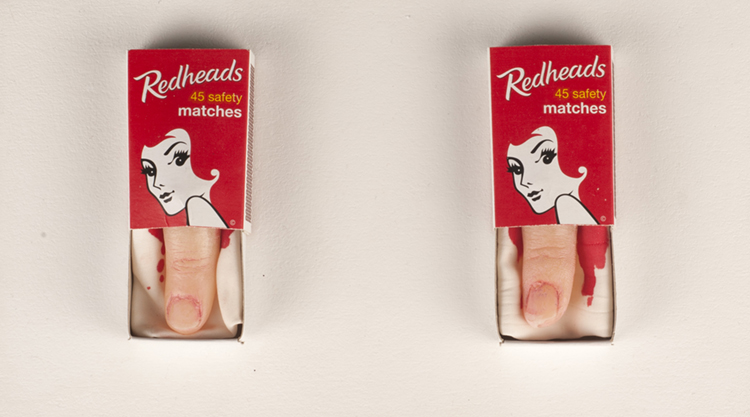
Bacchanalian, Bohemian, rebellious, intellectual, laid-back, sexually-available, a cigar-toting member of a city’s powerful elite or a smoke-wreathed demi-mondaine: smoking and its paraphernalia is freighted with so many associations that, in its dying days, the reduction of tobacco’s role to death-weed has left a gap in the symbolic guide book.
But for the Australian Impressionists in the 1880s and 90s, the symbolism of smoking was secondary to the usefulness of a friendly cigar merchant with some cedar box lids to spare.
More than 300 contemporary visual artists have contributed original artworks for the upcoming 9 X 5 NOW exhibition at the Victorian College of the Arts, which opens on 16 June 2017, at the University of Melbourne’s Margaret Lawrence Gallery. More information.